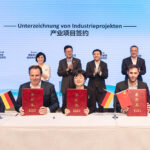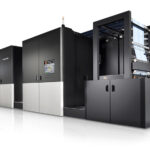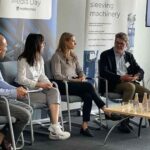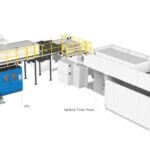Cartotecnica Veneta has installed the first QuadTech Color Quality Solution for gravure printing. A group work (with X-Rite, Huber and ColorConsulting) to automate the formulation of inks, reducing waste and start-up times. And much more.
Unlike most of Italy’s packaging converters, Cartotecnica Veneta is a generalist company. Its vast substrate portfolio – ranging from coated and uncoated paper and board, to aluminium foil and thin PP and PE films – requires different ink sets, unique color targets and accurately made gravure cylinders and flexo plates. Carrying out all these processes while guaranteeing constant quality results in a rational manner from an organizational and economic point of view is hence a prime target for the company

Simplify, automate, reduce
The gravure press operating at Cartotecnica Veneta is an old and formidable nine color, 1,250 mm web width Schiavi, that also carries out inline lamination of aluminium and metallized film and treatments such as varnishing and cold-seal.
Before adopting QuadTech’s Color Quality Solution, gravure inks were produced manually, using labor-intensive and wasteful procedures. Despite 80% of gravure runs being repeat orders, the amount of different and problematic substrates made ink formulation challenging, generating an excessive use of inks.
This is why the management turned to ColorConsulting with the objective or reaching a better working standard of results, as already successfully achieved with flexo printing. «Our main objective – Cartotecnica Veneta President Francesco Meneghetti explains – was to achieve tighter color control on the gravure line to reduce start-up time, waste and raw material usage. Furthermore, the ideal solution would involve sole set of basic inks, thus avoiding our having to store huge amounts of different colors for the various substrates. Lastly, we wanted to automate some processes as we have already done on our flexo lines, for a better use of human resources».
We soon realized that our solution would have to encompass the whole process: from cylinder production through to ink formulation, printing and output had to be correlated in order to coordinate the various parameters involved and facilitate communication. Carlo Carnelli of ColorConsulting concentrated on the Color Quality Solution launched at drupa 2012 by QuadTech, Huber Group and X-Rite. «It is a unique development – Carnelli explains – harnessing the strengths of three of the most advanced and proven color technology companies to share data in a common format. It will enable Cartotecnica Veneta to reduce the amount of base gravure inks thanks to Huber Group’s ink technology, as well as guarantee correct color targets from the beginning to the end of print, using QuadTech’s in-line spectral measurement expertise and X-Rite ink formulation software».

How the process has changed
The Color Quality Solution was installed at Cartotecnica Veneta in February 2013 and combines the advantages of in-line and off-line color measurement to get color first-time right for each print run. Here is how it works.
The formula. The process begins with the receipt of customer-defined color targets, the samples are evaluated off-line, manually, using the X-Rite SpectroEye; in this phase the QuadTech and X-Rite software enables the operator to set the color tolerance parameters and the ΔE deviation. A spectral color curve is thus obtained and loaded into X-Rite’s ink formulation software, which then creates an ink formula. A check is made in the special database, in order to verify whether the ink has already been used in previous jobs, to avoid unnecessary duplication.
The Huber color database transmits the data of the new formulas to the ink metering system to prepare the ink can. The semi-automatic production process makes use of software and precision scales. A set of scales is positioned in the gravure printing inking area, while a second mixing station is located by the press for easy on-the-job corrections without press stoppages (1).
Color control and data management. Cartotecnica Veneta creates up to seven new colors a day. To test the new ink formulas the company uses Harper Corporation’s The Phantom QD™, a portable table-top proofing system that easily changes from anilox roll to doctor blade and adapts to any ink or substrate. The output is then verified with a handheld X-rite SpectroEye, thus obtaining the correct color at the first attempt and consequently minimising waste.
Before start-up the color targets, ink quantities, viscosity, substrate, run length, and other parameters are sent to QuadTech’s Color Measurement System with SpectralCam™, utilising the QuadTech ICON platform (positioned close to the machine and network linked). This data is automatically “saved” so that it can be tracked or recalled at any time; return inks can also easily be found for re-use.
These functions are important in that 80% of the company’s print runs are repeat jobs, hence generating considerable savings.
 Continuous monitoring. The SpectralCam calculates accurate L*a*b*, ΔE and ΔDensity values and dot gain (2) in-line at maximum press speeds on virtually all web-fed materials, including transparent, translucent and opaque film substrates, in addition to paper. It measures multiple pre-defined color targets within the given artwork and is many times more sensitive to subtle color differences than the human eye.
Continuous monitoring. The SpectralCam calculates accurate L*a*b*, ΔE and ΔDensity values and dot gain (2) in-line at maximum press speeds on virtually all web-fed materials, including transparent, translucent and opaque film substrates, in addition to paper. It measures multiple pre-defined color targets within the given artwork and is many times more sensitive to subtle color differences than the human eye.
At Cartotecnica Veneta the SpectralCam is positioned after the last printing unit, measuring the defined color targets continually once the press is running. It monitors each of the nine colors on the Schiavi press separately and guarantees conformity during the entire print run.
The company also utilises QuadTech’s Web Stabilizer, that provides a stable, controlled way of taking spectral color measurements on thin transparent and opaque films without risk of compromising the same.

The results
Cartotecnica Veneta chief operator Andrea Meggiolaro sums up the benefits obtained thanks to the Color Quality Solution: «The new system helps us save a lot of time as the set-up of a job is simple, ink formulas can be easily found on the database and then made and proofed. Once the color is on the press our makeready time is significantly decreased. This is because we know exactly what to expect from the ink, cylinders and substrate combination and can rectify anything within minutes with the simple ICON platform».
But there is more. QuadTech’s Color Measurement System displays dot gain values of a final print, and this data can be provided to the cylinder engravers
to produce the cylinders.
Other noticeable changes – the company people state – include the significant decrease in ink usage and storage. «Ink cans used to fill two rooms (3), but now only fill a fifth of one room.
The extra space means that the new gravure press will easily fit into the factory without the need to carry out renovation work». Costs have also been cut due to the fact that the same base inks are now being used for all jobs, with varnishes added according to substrate properties.
Lastly, a non marginal notation: «The packaging of Nestlé Italy’s Buitoni range has a multi-layered substrate that includes plastic film on one side and an aluminium foil on the other. It is not easy to print, involving an operation that requires hours of tests and evaluations. However when the project heads saw the job preparation with the Color Quality Solution they agreed immediately. The quality and print methodology convinced them straight out».
Cartotecnica Veneta, founded in 1956, has two main printing sites in San Pietro in Gu (PD), covering 16,000 sqm. The Via Rebecca site is dedicated to printing and features a gravure printing line, soon to be joined by a second, and three flexo printing lines. Via Mazzini is dedicated to finishing, with laminators, extrusion lines, longitudinal slitting/rewinding and creasing machines. The company supplies finished and semi-finished products, primarily for large Italian and European food & beverage brands such as Ferrero, Nestlé Italia and Unilever.













